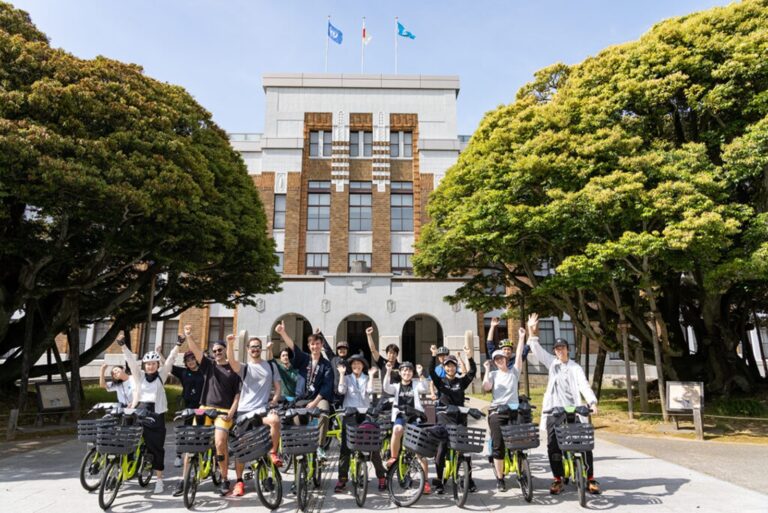May 22 is recognized as the UN Day for Biodiversity. In celebration of this occasion, a special event called the Kanazawa Japanese Garden Town Ride Tour was held the day before, on May 21.
About 20 people participated in this exclusive tour, which visited two privately owned gardens situated along rivers and waterways that flow in various directions throughout Kanazawa, a city known for its abundant water. The tour was led by Juan Juan, a researcher at the United Nations University OUIK, who specializes in urban green space ecosystems.
Additionally, participants used the Kanazawa City public shared bicycle service, “Machinori,” as their mode of transportation. This enabled them to enjoy the soothing sound of water, which cannot be experienced from a car, and the exhilaration of cutting through the wind, a feeling that’s not possible on foot. Moreover, it provided an opportunity to engage in an ecological tour with near-zero emissions, contributing to tangible efforts against climate change.
Experiencing the importance of biocultural diversity through waterways and gardens.
Participants gathered at Kanazawa Station and began their journey on Machinori bicycles. The electric-assist feature of the Machinori bikes ensures a smooth start, making it effortless to navigate even the gentle slopes along the route.
First, they traveled along the Kurazuki irrigation canal, making stops to hear lectures about the history and importance of Kanazawa’s irrigation system. Next, they continued along the Onosho canal toward the Naga-machi Bukeyashiki area. There, they visited a private garden at a samurai residence, which was one of their main stops, and enjoyed powdered green tea and sweets.
This pond-style garden, recognized as a Place of Scenic Beauty by Kanazawa City, was created by an ancestor of the current owner, Mr. Nobuhiro Ishino, who served the 13th feudal lord, Maeda Nariyasu. Mr. Ishino mentioned that the garden has a special charm and resembles Kenrokuen, especially with its two-legged lanterns.
The garden gets its water from the nearby Onosho irrigation canal, which flows through it before returning to the canal. Hearing from the owner about the garden’s beauty and the challenges of keeping it up was a great experience for them.
Although the garden is usually closed to the public, the owners have recently revived a waterfall that had not flowed for about a century and are thinking about offering tours like this in the future.
Enjoyable Cycling from Saikawa River to Asano River
As we ride along the expansive and charming banks of the Saikawa River, our journey included a stop at the Onosho water canal. After taking a commemorative photo in front of the Shiinoki Cultural Complex, where United Nations University OUIK office is located, we cross the Asanogawa Bridge, leading us to the foot of Mt Utatsuyama. This area has been designated as a national Important Preservation District for Groups of Traditional Buildings, featuring around 50 temples and shrines, along with a refined walking path known as “Kokoro no Michi” that connects these sacred sites.
Many roads in this region are narrow and inaccessible to cars, contributing to a decline in population and an aging demographic. Researcher Juan points out, “Please take note of the numerous vacant houses, yet you’ll also find that the area is rich in greenery.”
Our second stop was the Shinren Shrine, a Jodo sect shrine located in the complex. This shrine features a picturesque pond garden designed in the style of Kobori Enshu, a designated scenic beauty spot in Kanazawa City. The centerpiece, Shinji Pond, is nourished primarily by spring water, which remains abundant even during the dry summer months.
During our visit, we participated in a cleanup activity in the garden. We worked together to collect fallen leaves and debris from the lush moss on a steep and slippery slope. Though it took only a short time, our efforts quickly filled trash bags with the leaves we gathered.
Recognizing the importance of gardens that we had previously overlooked
Researcher Juan later gave a lecture on the unique characteristics and importance of gardens in Kanazawa.
One of the most notable features of Kanazawa’s gardens is their incorporation of water, which can be categorized into two main types: those that utilize irrigation water and those that draw from natural springs. Juan shared findings from a three-year survey of approximately 25 gardens, which highlighted that these gardens have contributed to an increase in urban biodiversity.
In addition, a survey focusing on well-being revealed that individuals who engaged with garden culture or participated in garden clean-up activities reported their mental health experiences. Notably, 80% of participants indicated that gardens positively influenced their emotions, while 54% experienced a decrease in negative feelings, such as anger and tension. However, Juan also addressed the pressing challenges facing these gardens: their numbers are dwindling rapidly, and a significant lack of maintenance—often due to aging owners—has led to a decline in biodiversity.
There is a growing need for a management system that addresses the challenges gardens face and helps lessen the burden on their owners. OUIK is researching tours that we believe can provide positive solutions for both garden owners and tourists.
We encourage tourists who care about sustainability and want to give back to the communities they visit to join these tours and “help preserve biodiversity.” Instead of just working on gardens, which are getting harder to maintain, tourists can enjoy special experiences like tea ceremonies, learning new things, and observing wildlife.
Participants of the tour shared their thoughts: “I learned how important it is to take care of gardens,” “I used to just think gardens were pretty, but now I see they have many important roles,” and “I believe tours like this, which let people engage with the SDGs, meet the needs of our world.”




